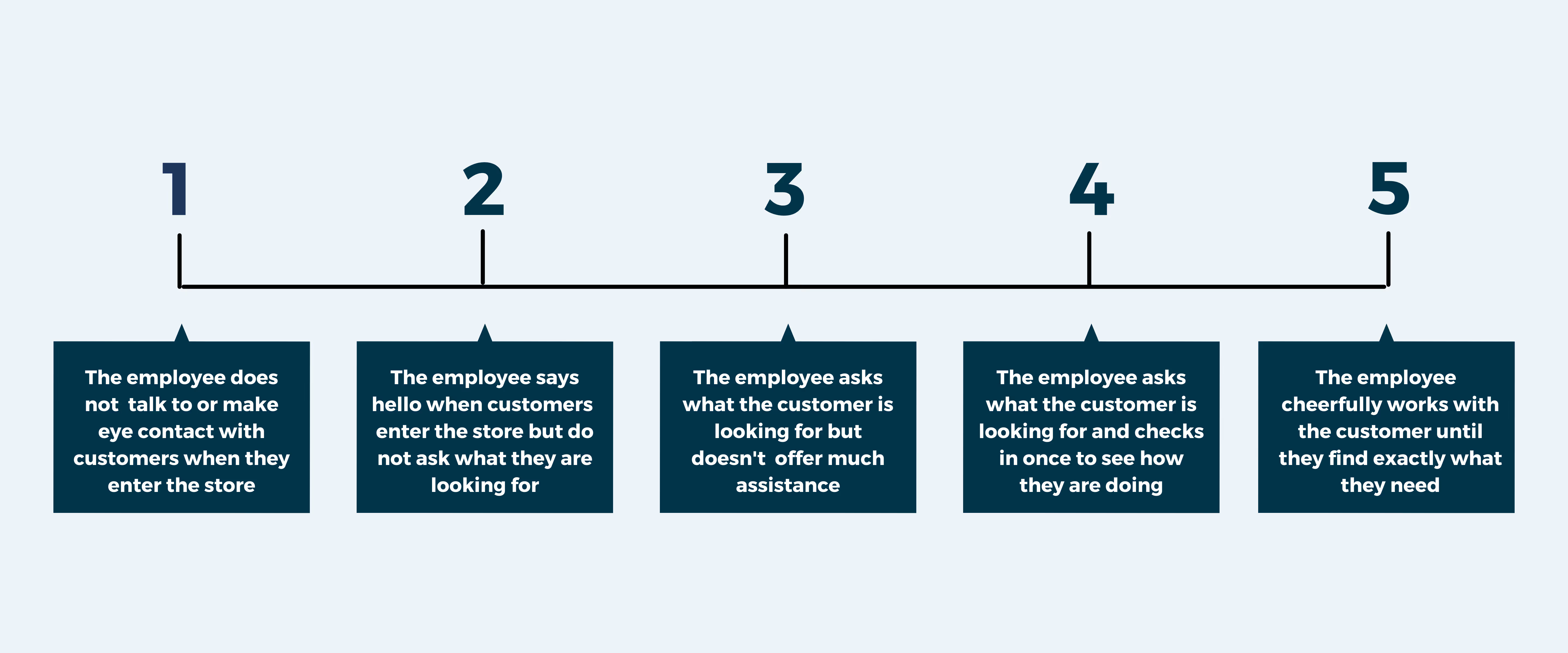Behavioral Observation Scales | Definition, Tips and Examples
You've probably interacted with Behavioral Observation Scales dozens of times. You just may not have known the term for it. A Behavioral Observation Scale (BOS) allows an observer to measure and quantify a behavior.
Here’s a quick example:
Employee completes tasks in a timely manner
Almost never
Seldom
Sometimes
Often
Almost always
An observer then selects the number that best corresponds to the employee’s behavior at work. BOS can be valuable for measuring performance without relying on hard metrics such as sales or touchpoints.
We want to show you how your HR team can use Behavioral Observation Scales to improve your performance review processes. Let’s take a look at some key examples of Behavioral Observation studies and the pros and cons of using them in your organization. At the end of the article, we'll dive into the best practices for implementing BOS.
What are Behavioral Observation Scales?
Behavioral observation scales are a measurement tool that measures the frequency of a behavior. They use a 5-point scale. 5 is “almost always, and 1 is “almost never.” The observer selects the appropriate value to match the behavior of the person being observed.
In simple terms, it grades you on how often you’re doing something.
Think about that for a moment – being able to determine how often you’re doing something can be valuable for a lot of organizations.
For example, in the late 70s, Behavioral Observation Scales were used to diagnose autism in children. A clinician would have 36 separate BOS questions they would fill out after observing a child’s behavior over time. Taking the values from these 36 different scales gave the observer a holistic view of the child.
For HR purposes, Behavioral Observation Scales measure employees’ performance against ideal behaviors. These behaviors can be tailored to each role.
You can easily swap in scales relevant to a Receptionist such as “greets guests promptly.” You can also add in scales for a Customer Success Manager such as “resolves clients’ issues without escalation.”
Using Behavioral Observation Scales provides a holistic look at your employee performance. It measures the frequency that your employees perform behaviors expected of them in their roles.
Examples of Behavioral Observations
Let’s mix it up – move away from the jargon – and look at some real-world behavioral observation examples.
Example 1: School
Here are some behavioral observation examples a teacher might use to evaluate a student.
- Arrives to class promptly
- Completes homework on time
- Treats fellow students with respect.
Example 2: Medical Evaluation
Here are some behavioral observation scale examples a doctor may use to evaluate pain present in a patient
- Moans, screams, or cries
- Moves cautiously to protect a damaged body part
- Communicates aggressively
- Refuses to communicate
Example 3: Performance Evaluation
Here are a few examples of BOS questions you could use when developing a performance evaluation.
- Arrives to work on time
- Communicates with teammates in a timely manner
- Completes projects by agreed-upon deadline
- Turns in work that needs minimal edits
- Treats coworkers with respect
Understanding the Difference Between BARS and BOS.
You may have also heard of the term “BARS.” This stands for Behaviorally Anchored Rating Scales. So, what is the difference between BARS and BOS?
Both terms refer to scales that can be used to measure performance. BOS is used to measure the frequency of a behavior. BARS assigns a specific descriptor to each level on a scale for the behavior being measured.

What does that look like in practice?
Let’s take a look at a BARS for “Customer Interaction.”
1: Does not greet customers as they enter the store.
2: Greets customers non-verbally.
3: Greets customers verbally while staring at phone or computer screen.
4: Greets customers with a simple “hello.”
5: Greets customers and asks them if they need any assistance.
So why would we use BARS over BOS?
With BARS, you can get much more specific in the behavior you’re grading. When the BARS metrics are shown ahead of time, employees understand what behaviors they should be modeling. Therefore, BARS can be a motivating tool for employees.
Some see BARS as more objective than BOS. The observer doesn’t have to determine if this employee performs the behavior some of the time or all of the time. They simply select the behavior that the employee exhibits.
Why would you use BOS over BARS?
BARS scales are more labor intensive. It takes longer to develop each scale. You need to assign a behavior to each number instead of looking at the frequency of the behavior being presented.
Imagine doing that for every role at your company (oy vey).
Another problem pops up when an employee shows behavior across multiple levels of a BARS scale.
For example, let’s say that an employee greets customers, and asks them if they need assistance. However, that employee was also viewing their computer monitor at the same time. This employee would be both a 2 and a 5 on the BARS scale.
In a situation like this, a manager would need to make a judgment call. This could lead to bias being injected into an overall rating.
BOS, in this situation, would reduce bias. Instead, with BOS, we would develop a single ideal behavior:
- Greets customers and asks them if they need any assistance; makes eye contact and does not stare at phone or monitor.
In this case, the observer would select the rating that best represents how frequently the employee shows that behavior.
In a way, BOS is simpler. It takes less time to develop and requires less observer training. Plus, it has fewer instances of an employee exhibiting behavior at both ends of the scale.
Pros and Cons of Using BOS
The behavioral observation scale method is an effective way to measure performance. That said, it does have drawbacks.
Pros of using BOS
- It’s standardized. The behaviors and numeric values are set ahead of time. The observer selects the correct value that represents the frequency of the behavior.
- No need for hard metrics. BOS can measure performance independent of metrics like sales numbers, open rates, touchpoints, or other KPIs.
- It’s faster to develop. Only the ideal behaviors need to be identified, not the behavioral anchors themselves.
- It’s flexible. Not every behavior is right for every role. You can quickly swap out different behaviors to tailor performance management to your employees.
- It’s great for analyzing core values. BOS is an excellent tool for quantifying how frequently your employees embody your core values.
Cons of using BOS
- You need to train observers. Observers need to undergo training to reduce bias and ensure they are giving accurate ratings.
- Data collection takes time. Observers need to take time to observe their employees. The grade an observer selects must accurately reflect the behavior over time.
- It can be subjective. What’s the difference between “often” and “almost always?” Sometimes, it can be hard to say. Personal bias may lead an observer to lean one way or the other when a behavior isn’t easily quantifiable.
- Doesn’t account for hard performance. BOS only addresses behaviors. It doesn’t address concepts such as closed deals, sales numbers, articles completed, or hours billed.
Best Practices for Implementing BOS
So you’ve read all the pros and cons and you’ve thought, “You know what, I want to add BOS to my performance review process.”
“How do I do that?”
Awesome. You’ve come to the right place. Here’s a quick rundown on how to get cracking on implementing BOS.
Define your behaviors
Pick the behaviors you want to measure and then clearly define them. Make sure you define the optimal version of the behavior, as you’ll be measuring how frequently your employees exhibit this behavior.
Train your observers
You’ll need to train your observers on how to observe accurately. They’ll also need training on how to observe behavior over an appropriate period of time and reduce bias. Importantly, you’ll need to make sure your observers’ ratings are consistent. Janine’s 2 (rarely) shouldn’t be the same as Ty’s 4 (almost always).
Keep things above board
It’s important that your review process is ethical and transparent. If one of the monitored behaviors is a customer service call, make sure that your employees know their calls are being monitored.
Review your processes
Every performance management system, whether it’s BOS or BARS, has flaws. It’s important to evaluate your processes from time to time. Solicit feedback, see what’s working, and see where you need to make some improvements.
Maybe BOS isn’t capturing all the data you need. In that case, you may want to supplement BOS with BARS (ADD LINK TO PERFORMYARD BARS) or some more metric-based performance review processes.
Remember: make your review process work for your organization!
Best Practices for Implementing Behavioral Observation Scales with Performance Management Software
Your performance management cycle is only as good as the software it’s housed in. Unless you like completing review cycles on an Excel sheet, you’ll need a user-friendly software system. PerformYard has the flexibility to let you personalize your performance management process with Behavioral Observation Scales.
The key factors to look out for when selecting performance management software are:
- User friendly. Your entire company will be using this to fill out reviews – don’t make it hard on them.
- Compatible with existing systems. Your software should integrate easily within your HRIS, so you can take advantage of your existing employee data
- Flexible. Your company is unique. Your performance management software should reflect that. It should let you customize every element of your review cycle from behaviors observed to review frequency.
PerformYard offers a flexible, customizable, and fully integrated Performance Management Solution. Use it to help your company implement Behavioral Observation Scales as part of your performance review process.
Curious to see it in action?


.jpg)

